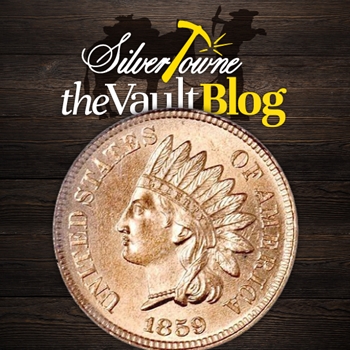
How many one-cent coin designs can you think of off the top of your head? If we had to guess, your answers most likely include the Lincoln Memorial cent and the Lincoln Wheat cent. Let’s take it back further though to the Large cent, Flying Eagle cent, and of course, the Indian Head cent. If you are a penny collector, most likely you have each of these or are more inclined to own just one of the varieties. Based on how long they were produced, we would take a guess that the Indian Head cent is a top choice among them.
But how much do you really know about the Indian Head cent design? While we often have them available online in grab bags, the 50 years the coin was in production during the late 1800s into the early 20th century has a lot of history.
Indian Head Cent Beginnings
At the beginning of the 1850s, the price of copper caused the United States Mint to reconsider the size of its pennies. At the time, large cents were still being used. The reduction of their size in addition to a different composition was needed to move forward with the cent coins. In reaction to these needs, the Mint shortly thereafter produced the Flying Eagle Penny from 1856-1858.
This new cent coin was comprised of less than 90% copper and experienced design issues almost immediately. In fact, then-Director of the Mint James Ross Snowden composed a letter to the Secretary of the Treasury in November of 1858 suggesting that the change in design be made. His argument included that the relief of the coin was too high and that the public was not completely on board with it. Thus, designs were submitted for the new one-cent coin and later approved. This new coin would be the Indian Head cent.
The Design
Designed by the fourth Chief Engraver of the United States, James Barton Longacre, the Indian Head cent was produced from 1859-1909. The obverse of the design features an Indian head facing to the left wearing a feather bonnet. “UNITED STATES OF AMERICA” is seen inscribed around the outer edge of the coin with the year date at the bottom. The word “LIBERTY” is also seen in the band across the bonnet. The reverse shows the words “ONE CENT” in the middle of the coin with a laurel wreath around the whole rim. (Note: The 1860 design was changed showing the “ONE CENT” within the oak wreath while three arrows are seen under a ribbon that combines the two branches of the wreath.)
The design itself is said to be depicting Lady Liberty wearing a traditional Native American headdress. Some say that the design of the coin stems from the use of Longacre’s daughter as his model. However, no such evidence has been confirmed for this rumor.
Composition and Production
From 1859-1864, the coins were struck in 88% copper and 12% nickel as required by law. In 1864, the weight of the coins was reduced from 72 to 48 in terms of grains. The alloy was also changed to 95% copper and 5% tin and zinc. It was found by further research that bronze was a highly acceptable alloy for minor coins.
With 50 years in total production, it was finally passed in late April of 1906 by Congress (just three years before it ended) that other Mint facilities were allowed to produce the penny. When it was first introduced, the one-cent coin and the five-cent nickel were limited by law to the Philadelphia Mint.







